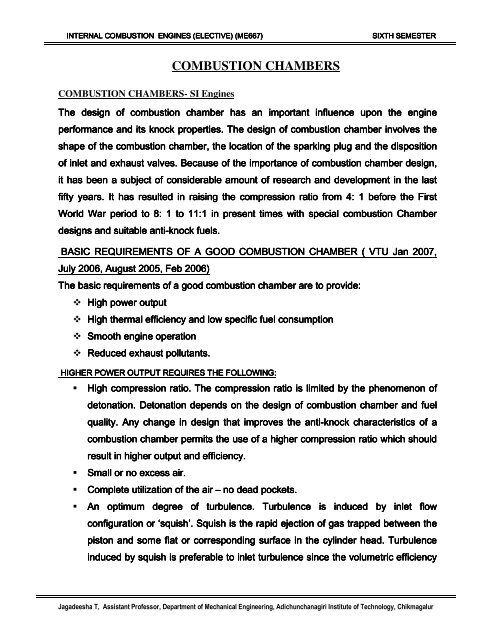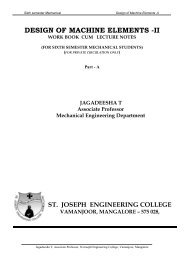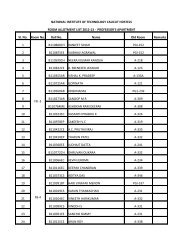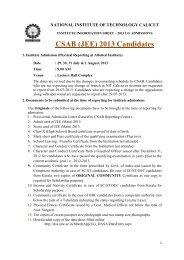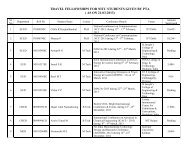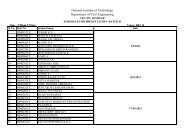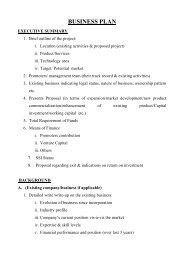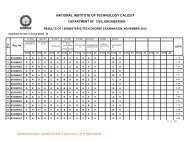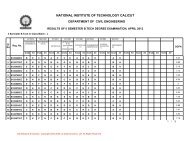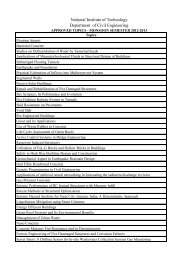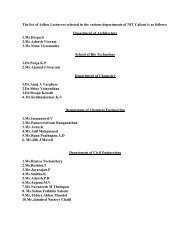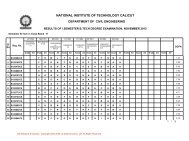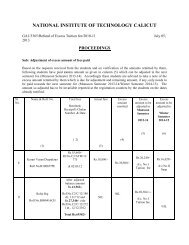COMBUSTION CHAMBERS - National Institute of Technology
COMBUSTION CHAMBERS - National Institute of Technology
COMBUSTION CHAMBERS - National Institute of Technology
Create successful ePaper yourself
Turn your PDF publications into a flip-book with our unique Google optimized e-Paper software.
INTERNAL <strong>COMBUSTION</strong> ENGINES (ELECTIVE) (ME667)SIXTH SEMESTER<strong>COMBUSTION</strong> <strong>CHAMBERS</strong><strong>COMBUSTION</strong> <strong>CHAMBERS</strong>- SI EnginesThe design <strong>of</strong> combustion chamber has an important influence upon the engineperformance and its knock properties. The design <strong>of</strong> combustion chamber involves theshape <strong>of</strong> the combustion chamber, the location <strong>of</strong> the sparking plug and the disposition<strong>of</strong> inlet and exhaust valves. Because <strong>of</strong> the importance <strong>of</strong> combustion chamber design,it has been a subject <strong>of</strong> considerable amount <strong>of</strong> research and development in the lastfifty years. It has resulted in raising the compression ratio from 4: 4: 1 before the FirstWorld War period to 8: 1 to 11:1 in present times with special combustion Chamberdesigns and suitable anti-knock fuels.BASIC REQUIREMENTS OF A GOOD <strong>COMBUSTION</strong> CHAMBER ( VTU Jan 2007,July 2006, August 2005, Feb 2006)The basic requirements <strong>of</strong> a good combustion chamber are to provide: High power output High thermal efficiency and low specific fuel consumption Smooth engine operation Reduced exhaust pollutants.HIGHER POWER OUTPUT REQUIRES THE FOLLOWING: High compression ratio. The compression ratio is limited by the phenomenon <strong>of</strong>detonation. Detonation depends on the design <strong>of</strong> combustion chamber and fuelquality. Any change in design that improves the anti-knock characteristics <strong>of</strong> acombustion chamber permits the use <strong>of</strong> a higher compression ratio which shouldresult in higher output and efficiency. Small or no excess air. Complete utilization <strong>of</strong> the air – no dead pockets. An optimum degree <strong>of</strong> turbulence. Turbulence is induced by inlet flowconfiguration or ‘squish’. Squish is the rapid ejection <strong>of</strong> gas trapped between thepiston and some flat or corresponding surface in the cylinder head. Turbulenceinduced by squish is preferable to inlet turbulence since the volumetric efficiencyJagadeesha T, Assistant Pr<strong>of</strong>essor, Department <strong>of</strong> Mechanical Engineering, Adichunchanagiri <strong>Institute</strong> <strong>of</strong> <strong>Technology</strong>, Chikmagalur
INTERNAL <strong>COMBUSTION</strong> ENGINES (ELECTIVE) (ME667)SIXTH SEMESTERis not affected. High Volumetric Efficiency. . This is achieved by having large diameter valves withample clearance round the valve heads, proper valve timing and straightpassage ways by streamlining the combustion chamber so that the flow is withlesser pressure drop. This means more charge per stroke and proportionateincrease in the power output. Large valves and straight passageways alsoincrease the speed at which the maximum power is obtained. This furtherincreases the power pby increasing the displacement per minute.(B) HIGH THERMAL EFFICIENCY REQUIRES THE FOLLOWING: High compression ratio: Already discussed. A small heat loss during combustion. This is achieved by having a compactcombustion chamber which provides small surface-volume ratio. The otheradvantage <strong>of</strong> compact ct combustion chamber is reduced flame travel a giventurbulence, this reduces the time <strong>of</strong> combustion and hence combustion time lossGood scavenging <strong>of</strong> the exhaust gases.(C) SMOOTH ENGINE OPERATION REQUIRES THE FOLLOWING: Moderate rate <strong>of</strong> pressure rise during combustion. Absence <strong>of</strong> detonation which in turn means: Compact combustion chamber, short distance <strong>of</strong> flame travel from the sparkingplug to the farthest point in the combustion space. Pockets in which stagnantgas may collect should be avoided. Properlocation <strong>of</strong> the spark plug and exhaust valve. Satisfactory cooling <strong>of</strong> the spark plug points (to avoid pre ignition) and <strong>of</strong> exhaustvalve head which is the hottest region <strong>of</strong> the combustion chamber.(D) Reduced exhaust pollutants Exhaust pollutants can be reduced by designing a combustion chamber thatproduces a faster burning rate <strong>of</strong> fuel. A faster burning chamber with its shorterJagadeesha T, Assistant Pr<strong>of</strong>essor, Department <strong>of</strong> Mechanical Engineering, Adichunchanagiri <strong>Institute</strong> <strong>of</strong> <strong>Technology</strong>, Chikmagalur
INTERNAL <strong>COMBUSTION</strong> ENGINES (ELECTIVE) (ME667)SIXTH SEMESTERburning time permits operation with substantially higher amounts <strong>of</strong> Exhaust GasRecirculation (EGR), which reduces the oxides <strong>of</strong> nitrogen (NOX) ) in the exhaustgas without substantial in crease in the hydrocarbon emissions. It can also burnvery lean mixtures within the normal constraints <strong>of</strong> engine smoothness andresponse. A faster burning chamber exhibits much less cyclic variations,permitting the normal combustion at part load to have greater dilution <strong>of</strong> thecharge.DIFFERENT TYPES OF <strong>COMBUSTION</strong> <strong>CHAMBERS</strong>A few representative types <strong>of</strong> combustion chambers <strong>of</strong> which there are many moreVariations are enumerated and discussed below:1. T-head Tcombustion chamber.2. L-head Lcombustion chamber.3. I-head I(or overhead valve) combustion chamber.4. F-head Fcombustion chamber.It may be noted that these chambers are designed to obtain the objectives namely:• A high combustion rate at the start.• A high surface-toto-volume ratio near the end <strong>of</strong> burning.• A rather centrally located spark plug.T Head Type Combustion chambersThis was first introduced by Ford Motor Corporation in 1908. This design has followingdisadvantages.o Requires two cam shafts (for actuatingthe in-let valve and exhaust valveseparately) by two cams mounted on thetwo cam shafts.o Very prone to detonation. There wasviolent detonation even at a compressionratio <strong>of</strong> 4. 4. This is because the averageoctane number in 1908 was about 40 -50.Jagadeesha T, Assistant Pr<strong>of</strong>essor, Department <strong>of</strong> Mechanical Engineering, Adichunchanagiri <strong>Institute</strong> <strong>of</strong> <strong>Technology</strong>, Chikmagalur
INTERNAL <strong>COMBUSTION</strong> ENGINES (ELECTIVE) (ME667)SIXTH SEMESTERL Head Type Combustion chambers (VTU JAN 2007)It is a modification <strong>of</strong> the T-head Ttype <strong>of</strong> combustion chamber. It provides the two valueson the same side <strong>of</strong> the cylinder, and the valves are operated through tappet by a singlecamshaft. This was first introduced by Ford motor in 1910-30 and was quite popular forsome time. This design has an advantage both from manufacturing and maintenancepoint <strong>of</strong> view.Advantages:o Valve mechanism is simple and easy to lubricate.o Detachable head easy to remove for cleaning and decarburizing withoutdisturbing either the valve gear or main pipe work.o Valves <strong>of</strong> larger sizes can be provided.Disadvantages:o Lack <strong>of</strong> turbulence as the air had to take two right angle turns to enter thecylinder and in doing so smuch initial velocity is lost.o Extremely prone to detonation due to large flame length and slow combustiondue to lack <strong>of</strong> turbulence.o More surface-toto-volume ratio and therefore more heat loss.o Extremely sensitive to ignition timing due to slow combustion on processo Valve size restricted.o Thermal failure in cylinder block also. In I-headIengine the thermal failure is confined to cylinderhead onlyJagadeesha T, Assistant Pr<strong>of</strong>essor, Department <strong>of</strong> Mechanical Engineering, Adichunchanagiri <strong>Institute</strong> <strong>of</strong> <strong>Technology</strong>, Chikmagalur
INTERNAL <strong>COMBUSTION</strong> ENGINES (ELECTIVE) (ME667)SIXTH SEMESTERRICARDO’S TURBULENT HEAD– SIDE VALVE <strong>COMBUSTION</strong> CHAMBER ( VTU July 0( VTU July 06)Ricardo developed this head in 1919. His main objective was to obtain fast flame speedand reduce knock in L design. In Ricardo’s design the main body <strong>of</strong> combustionchamber was concentrated over the valves, leaving slightly restricted passagecommunicating with cylinder.Advantages:o Additional turbulence during compression strokeis possible as gases are forced back through thepassage.o By varying throat area <strong>of</strong> passage designeddegree <strong>of</strong> additional turbulence is possible.o This design ensures a more homogeneousmixture by scoring away ay the layer <strong>of</strong> stagnant gas clinging to chamber wall. Boththe above factors increase the flame speed and thus the performance.o Deign make engine relatively insensitive to timing <strong>of</strong> spark due to fastcombustiono Higher engine speed is possible due to increased turbulenceo Ricardo’s design reduced the tendency to knock by shortening length <strong>of</strong> effectiveflame travel by bringing that portion <strong>of</strong> head which lay over the further side <strong>of</strong>piston into as close a contact as possible with piston crown.o This design reduces length <strong>of</strong> flame travel by placing the spark plug in the centre<strong>of</strong> effective combustion space.Disadvantages :o With compression ratio <strong>of</strong> 6, normal speed <strong>of</strong> burning increases and turbulenthead tends to become over turbulent and rate <strong>of</strong> pressure rise becomes too rapidleads to rough running and high heat losses.o To overcome the above problem, Ricardo decreased the areas <strong>of</strong> passage at theexpense <strong>of</strong> reducing the clearance volume and restricting the size <strong>of</strong> valves. Thisreduced breathing capacity <strong>of</strong> engine, therefore these types <strong>of</strong> chambers are notsuitable for engine with high compression ratio.Jagadeesha T, Assistant Pr<strong>of</strong>essor, Department <strong>of</strong> Mechanical Engineering, Adichunchanagiri <strong>Institute</strong> <strong>of</strong> <strong>Technology</strong>, Chikmagalur
INTERNAL <strong>COMBUSTION</strong> ENGINES (ELECTIVE) (ME667)SIXTH SEMESTEROver head valve or I head combustion chamber ( VTU JULY( VTU JULY 2007/ / August 2005)The disappearance <strong>of</strong> the side valve or L-head Ldesign was inevitable at highcompression ratio <strong>of</strong> 8 : 1 because <strong>of</strong> the lack <strong>of</strong> space in the combustion chamber toaccommodate the valves. Diesel engines, with high compression ratios, invariably usedoverhead valve design.Since 1950 or so mostly overhead valve combustionchambers are used. This type <strong>of</strong> combustion chamber hasboth the inlet valve and the exhaust valve located in thecylinder head. An overhead engine is superior to side valveengine at high compression ratios.The overhead valve engine is superior to side valve or L-Lhead engine e at high compression ratios, for the followingreasons:o Lower pumping losses and higher volumetricefficiency from better breathing <strong>of</strong> the engine fromlarger valves or valve lifts and more direct passageways.o Less distance for the flame to travel and therefore efore greater freedom from knock,or in other words, lower octane requirements.oooLess force on the head bolts and therefore less possibility <strong>of</strong> leakage (<strong>of</strong>compression gases or jacket water). The projected area <strong>of</strong> a side valvecombustion chamber is inevitably greater than that <strong>of</strong> an overhead valvechamber.Removal <strong>of</strong> the hot exhaust valve from the block to the head, thus confining heatfailures to the head. Absence <strong>of</strong> exhaust valve from block also results in moreuniform cooling <strong>of</strong> cylinder and piston.Lower surface-volume ratio and, therefore, less heat loss and less air pollution.o Easier to cast and hence lower casting cost.Jagadeesha T, Assistant Pr<strong>of</strong>essor, Department <strong>of</strong> Mechanical Engineering, Adichunchanagiri <strong>Institute</strong> <strong>of</strong> <strong>Technology</strong>, Chikmagalur
INTERNAL <strong>COMBUSTION</strong> ENGINES (ELECTIVE) (ME667)SIXTH SEMESTERTwo important designs <strong>of</strong> overhead valve combustion chambers are used .Bath Tub Combustion Chamber. This is simple and mechanicallyconvenient form. Thisconsists <strong>of</strong> an oval shaped chamber with both valves mounted vertically overhead andwith the spark plug at the side. The main drawback <strong>of</strong> this design is both valves are placed in asingle row along the cylinder block. This limits its thebreathing capacity <strong>of</strong> engine, unless the overalllength is increased. However, modern enginemanufactures overcome this problem by usingunity ratio for stroke and bore size.Wedge Type Combustion Chamber.In thisdesign slightly inclined valves are used. This design also has given very satisfactoryperformance. A modern wedge type design can be seen in for Plymouth V-8 engine. Ithas a stoke <strong>of</strong> 99 mm and bore <strong>of</strong> 84mm with compression ratio 9:1F- Head combustion chamber ( VTU J( VTU JULY 2007/ / July 2005)In such a combustion chamber one valve is in head and other in the block. This designis a compromise between L-head Land I-head Icombustion chambers. One <strong>of</strong> the most F-Fhead engines (wedge type) is the one used by the Rover Company for several years.Another successful design <strong>of</strong> this type <strong>of</strong> chamber is that used in WilleysjeepsJagadeesha T, Assistant Pr<strong>of</strong>essor, Department <strong>of</strong> Mechanical Engineering, Adichunchanagiri <strong>Institute</strong> <strong>of</strong> <strong>Technology</strong>, Chikmagalur
INTERNAL <strong>COMBUSTION</strong> ENGINES (ELECTIVE) (ME667)SIXTH SEMESTERIts advantages are :o High volumetric efficiencyo Maximum compression ratio for fuel <strong>of</strong> given octane ratingo High thermal efficiencyo It can operate on leaner air-fuel ratios without misfiring.The drawback This design is the complex mechanism for r operation <strong>of</strong> valves and expensivespecial shaped piston.F- head used by Rover CompanyF – head used in Willeys jeep.Divided Combustion Chamber( VTU( VTU July 2006)In this type <strong>of</strong> chambers usually with about 80percent <strong>of</strong> the clearance volume in the mainchamber above the piston and about 20 percent <strong>of</strong>the volume as a secondary chamber. Mainchamber is connected to secondary chamberthrough a small orifice Combustion is started inthe small secondary chamber. As the gases insecondary chambers are consumed bycombustion, pressure rises and flaming gasexpands back through orifice and act as torchignition for main chamber.Jagadeesha T, Assistant Pr<strong>of</strong>essor, Department <strong>of</strong> Mechanical Engineering, Adichunchanagiri <strong>Institute</strong> <strong>of</strong> <strong>Technology</strong>, Chikmagalur
INTERNAL <strong>COMBUSTION</strong> ENGINES (ELECTIVE) (ME667)SIXTH SEMESTERSecondecondary chamber has high swirl and designed to handle rich mixture. The richmixture with very high swirl in secondary chamber will ignite readily and burn veryquickly. The flame gas expands through orifice and ignites the lean mixture in the mainchamber. The net result is an engine that has good ignition and combustion and yetoperates mostly lean to give good fuel economy.<strong>COMBUSTION</strong> <strong>CHAMBERS</strong>- CI EnginesPrimary Considerations in the Design <strong>of</strong> Combustion Chambers for C.I EnginesIn C engines fuel is injected into the combustion chamber at about 15°C before T.D.C.during the compression stroke. For the best efficiency the combustion must completewithin 15° to 20° <strong>of</strong> crank rotation after T.D.C. in the working stroke. Thus it is clear thatinjection and combusbustion both must complete in the short time. For best combustionmixing should be completed in the short time.• In S.I engine mixing takes place in carburetor; however in C.I engines this has to bedone in the combustion chamber. To achieve this requirement ent in a short period is anextremely difficult job particularly in high speed Cl. engines.• From combustion phenomenon <strong>of</strong> C.I. engines it is evident that fuel-air contact mustbe limited during the delay period in order to limit, the rate <strong>of</strong> pressure rise in the secondstage <strong>of</strong> combustion. This result can be obtained by shortening the delay to tachievehigh efficiency and power the combustion must be completed when piston is nearer toT.D.C., it is necessary to have rapid mixing <strong>of</strong> fuel and air dun the third stage <strong>of</strong>combustion.• The design <strong>of</strong> combustion chamber for C.I. engines must also take consideration <strong>of</strong>injection system and nozzles to be used.The considerations can be summarized as follows:1. High thermal efficiency.2. Ability to use less expensive fuel (multi-fuel).3. Ease <strong>of</strong> starting.4. Ability to handle variations in speed.Jagadeesha T, Assistant Pr<strong>of</strong>essor, Department <strong>of</strong> Mechanical Engineering, Adichunchanagiri <strong>Institute</strong> <strong>of</strong> <strong>Technology</strong>, Chikmagalur
INTERNAL <strong>COMBUSTION</strong> ENGINES (ELECTIVE) (ME667)SIXTH SEMESTER5. Smoothness <strong>of</strong> operation i.e. avoidance <strong>of</strong> diesel knock and noise.6. Low exhaust emission.7. Nozzle design.8. High volumetric efficiency.9. High brake Mean effective pressure.Role <strong>of</strong> air swirl in Diesel engine ( July 2005)Most important function <strong>of</strong> CI engine combustion chamber is to provide proper mixing <strong>of</strong>fuel and air in short possible time. For this purpose an organized air movement calledair swirl is to be produced pto produce high relative velocity between the fuel dropletsand air.There are three basic methods <strong>of</strong> generating swirl in CI engine Combustion Chamber. By directing the flow <strong>of</strong> air during its entry to the cylinder known as Induction swirl.This method is used in open combustion chamber. By forcing air through a tangential passage into a separate swirl chamber duringthe compression stroke, known as Combustion swirl. This is used in swirlchamber. By use <strong>of</strong> initial pressure rise due to partial combustion to create swirl andturbulence, known as combustion induced swirl. . This method is used in pre-combustion chamber and air cell chambers.INDUCTION SWIRL ( July 2006)Swirl refers to a rotational flow within the cylinder about its axes.In a four strokroke engine induction swirl can be obtained either by careful formation <strong>of</strong> airintake passages or masking or shrouding a portion <strong>of</strong> circumference <strong>of</strong> inlet valve. Theangle <strong>of</strong> mask is from 90° to 140° <strong>of</strong> the circumference. In two stroke engine, inductionswirl is created by suitable inlet port forms. Induction swirl can be generated usingfollowing methods. Swirl is generated by constructing the intake system togive a tangential component to intake flow as it entersthe cylinder. This is done by shaping and contouringthe intake manifold,Jagadeesha T, Assistant Pr<strong>of</strong>essor, Department <strong>of</strong> Mechanical Engineering, Adichunchanagiri <strong>Institute</strong> <strong>of</strong> <strong>Technology</strong>, Chikmagalur
INTERNAL <strong>COMBUSTION</strong> ENGINES (ELECTIVE) (ME667)SIXTH SEMESTER Swirl can be generated by masking one side <strong>of</strong> theinlet valve so that air is admitted only around a part <strong>of</strong>the periphery <strong>of</strong> the valve and in the desired direction. Swirl can also be generated by casting a lip over oneside <strong>of</strong> the inlet valve.Swirl generated by induction isvery weak. Thus singleorifice injection cannot provide the desired air fuel mixing.Therefore, with Induction swirl, it is advisable to use amultiple-orifice injector.Advantages <strong>of</strong> Induction swirl.o Easier starting (due to low intensity <strong>of</strong> swirl).o High excess air (low temperature), lowturbulence (less heat loss), therefore indicatedthermal efficiency is high.o Production <strong>of</strong> swirl requires no additional work.o Used with low speeds, therefore low quality q<strong>of</strong>fuel can be used.Disadvantages <strong>of</strong> induction swirl:o Shrouded valves, smaller valves, low volumetric efficiency.oWeak swirl, low air r utilisation (60%), lower M.E.P. . and large size (costly) engine.o Weak swirl, multi-orifice nozzle, high induction pressure; e; clogging <strong>of</strong> holes, highmaintenance.o Swirl not proportional to speed; efficiency not maintained at variable speedengine.o Influence minimum quantity <strong>of</strong> fuel. Complication at high loads and idling.Jagadeesha T, Assistant Pr<strong>of</strong>essor, Department <strong>of</strong> Mechanical Engineering, Adichunchanagiri <strong>Institute</strong> <strong>of</strong> <strong>Technology</strong>, Chikmagalur
INTERNAL <strong>COMBUSTION</strong> ENGINES (ELECTIVE) (ME667)SIXTH SEMESTERCOMPRESSION SWIRL ( July 2006)Compression swirl is generated using swirlchamber. A swirl chamber is a dividedchamber. A divided combustion chamberis defined as one in which the combustionspace is divided into two or morecompartments. Pressure differencebetween these chambers is created byrestrictions or throats. Very strong swirl canbe generated using compression swirl.Advantage <strong>of</strong> compression swirl: Large valves, high volumetric efficiency. Single injector, pintle type (self cleaning), less maintenance. Smooth engine operation. Greater air autilization due to strong swirl. Smaller (cheaper) engine. Swirl proportional to speed, suitable for variable speed operation.Disadvantage <strong>of</strong> compression swirl: Cold starting trouble due to high loss du to strong swirl, mechanical efficiency I Less excess ess air ; lower indicated efficiency; 5 to 8% more fuel consumption;decreasedexhaust valve life Cylinder more expensive in construction. Work absorbed in producing swirl, mechanical efficiency lower.Jagadeesha T, Assistant Pr<strong>of</strong>essor, Department <strong>of</strong> Mechanical Engineering, Adichunchanagiri <strong>Institute</strong> <strong>of</strong> <strong>Technology</strong>, Chikmagalur
INTERNAL <strong>COMBUSTION</strong> ENGINES (ELECTIVE) (ME667)SIXTH SEMESTER<strong>COMBUSTION</strong> INDUCTION SWIRL ( July 2006)This is created due to partial combustion, therefore known as combustion induced swirl.This method is used only in pre-combustion chamber. In this method, upwardmovement <strong>of</strong> piston during compression forces the air tangentially and fuel is injected inpre-combuscombustion , when the combustion <strong>of</strong> the accumulated fuel during delay periodsburns rapidly in pre-combustion chamber as A:F mixture is rich and forces the gases ata very high velocity in the main combustion chamber. This creates a good swirl andprovides better r combustion.Jagadeesha T, Assistant Pr<strong>of</strong>essor, Department <strong>of</strong> Mechanical Engineering, Adichunchanagiri <strong>Institute</strong> <strong>of</strong> <strong>Technology</strong>, Chikmagalur
INTERNAL <strong>COMBUSTION</strong> ENGINES (ELECTIVE) (ME667)SIXTH SEMESTERThe requirement <strong>of</strong> air motion and swirl in a C.I engine combustion chamber is muchmore stringent than in an S.I. engine.-Justify this statement? Air motions are required in both S.I. and C.I. engines. In S.I. engine, we call itturbulence and ain C.I. engine, we call it swirl. Turbulence which is required in S.I.engines implies disordered air motion with no general direction <strong>of</strong> flow, to breakup the surface <strong>of</strong> flame front and to distribute flame throughout an externallyprepared combustible mixture. Air swirl which is required in C.I. engines is anorderly movement <strong>of</strong> whole body <strong>of</strong> air with a particular direction <strong>of</strong> flow to bring acontinuous supply <strong>of</strong> fresh air to each burning droplet and sweep away theproducts <strong>of</strong> combustion which otherwise would suffocate it. If there is no turbulence in S.I. engines, the time occupied by each explosionwould be so great as to make high speed internal combustion enginesimpracticable. Insufficient turbulence lowers the efficiency due to incompletecombustion <strong>of</strong> fuel. In case <strong>of</strong> C.I. engines, it is impossible to inject fuel dropletsso that they distribute uniformly throughout the combustion space, the fuel airmixture formed in combustion chamber is essentially heterogeneous. Underthese conditions, if the air awithin the cylinder were motionless, only a smallportion <strong>of</strong> fuel would find sufficient oxygen and even burning <strong>of</strong> this fuel would beslow or even choked. So it is essential to impart swirl to air so that a continuoussupply <strong>of</strong> fresh air is brought to each eburning droplet and the products <strong>of</strong>combustion are swept away.The induction swirl in a C.I. engine helps in increasing indicated thermal efficiency.Justify this statement.Induction swirl is used in direct injection type engines, where the entire combustionspace is directly above the piston, and hence the surface-toto-volume ratio <strong>of</strong> thecombustion chamber is low. Further, the compressed air and the combustion productsdo not have to pass through a neck narrow connecting passage. Also, the meancombustion temperatures are lower, and there is less turbulence. All these factors resultin less heat losses, and thus the indicated thermal efficiency is increased.Jagadeesha T, Assistant Pr<strong>of</strong>essor, Department <strong>of</strong> Mechanical Engineering, Adichunchanagiri <strong>Institute</strong> <strong>of</strong> <strong>Technology</strong>, Chikmagalur
INTERNAL <strong>COMBUSTION</strong> ENGINES (ELECTIVE) (ME667)SIXTH SEMESTERTYPES OF <strong>COMBUSTION</strong> <strong>CHAMBERS</strong>- CI EnginesThe most important function <strong>of</strong> CI engine combustion chamber is to provide propermixing <strong>of</strong> fuel and air in short time. In order to achieve this, , an organized air movementcalled swirl is provided to produce high relative velocity between the fuel droplets andthe air.When the liquid fuel is injected into combustion chamber, , the spray cone gets disturbeddue to air motion and turbulence inside. The onset <strong>of</strong> combustion will cause an addedturbulence that can be guide d by the shape <strong>of</strong> the combustion chamber, makes itnecessary to study the combustion design in detail.C I engine combustion chambers are classified into two categories:1. OPEN INJECTION (DI) TYPE : This type <strong>of</strong> combustion chamber is also calledan Open combustion chamber. In this type the entire volume <strong>of</strong> combustionchamber is located in the main cylinder and the fuel is injected into this volume.2. INDIRECT INJECTION (IDI) TYPE: in this type <strong>of</strong> combustion chambers, thecombustion space is divided into two parts, one part in the main cylinder and theother part in the cylinder head. The fuel –injecinjection is effected usually into thepart <strong>of</strong> chamber located in the cylinder head. These chambers are classifiedfurther into :a) Swirl chamber in which compression swirl is generatedb) Pre combustion chamber in which combustion swirl is inducedc) Air cell in which both compression and combustion swirl are induced.DIRECT INJECTION <strong>CHAMBERS</strong> – OPEN <strong>COMBUSTION</strong> <strong>CHAMBERS</strong>An open combustion chamber is defined as one in which the combustion space isessentially a single cavity with little restriction from one part <strong>of</strong> the chamber to the otherand hence with no large difference in pressure between parts <strong>of</strong> the chamber during thecombustion process. There are many designs <strong>of</strong> open chamber some <strong>of</strong> which areshown below :In four-stroke engines with open combustion chambers, induction iswirl is obtainedeither by careful formation <strong>of</strong> the air intake passages or by masking a portion <strong>of</strong> theJagadeesha T, Assistant Pr<strong>of</strong>essor, Department <strong>of</strong> Mechanical Engineering, Adichunchanagiri <strong>Institute</strong> <strong>of</strong> <strong>Technology</strong>, Chikmagalur
INTERNAL <strong>COMBUSTION</strong> ENGINES (ELECTIVE) (ME667)SIXTH SEMESTERcircumference <strong>of</strong> the inlet valve whereas in two-stroke engines it is created by suitableform for the inlet ports.These chambers mainly consist <strong>of</strong> space formed between a flat cylinder head and acavity in the piston crown in different shapes. The fuel is injected directly into space.The injection nozzles used for this chamber are generally <strong>of</strong> multi hole type working at arelatively high pressure e ( about 200 bar)The main advantages <strong>of</strong> this type <strong>of</strong> chambers are:o Minimum heat loss during compression because <strong>of</strong> lower surface area tovolume ratio and hence, better efficiency.o No cold starting problems.o Fine atomization because <strong>of</strong> multi hole nozzle.The drawbacks <strong>of</strong> these combustion chambers are:o High fuel-injection pressure required and hence complex design <strong>of</strong> fuel-injection pump.o Necessity <strong>of</strong> accurate metering <strong>of</strong> fuel by the injection system, particularlyfor small engines.Shallow Depth Chamber:In shallow depth chamber the depth <strong>of</strong> the cavity provided inthe piston is quite small. This chamber is usually adopted for large engines running atlow speeds. Since the cavity diameter is very large, the squish is negligible.Hemispherical Chamber: This chamber also gives small squish. However, the depth todiameter ratio for a cylindrical chamber can be varied to give any desired squish to givebetter performance.Jagadeesha T, Assistant Pr<strong>of</strong>essor, Department <strong>of</strong> Mechanical Engineering, Adichunchanagiri <strong>Institute</strong> <strong>of</strong> <strong>Technology</strong>, Chikmagalur
INTERNAL <strong>COMBUSTION</strong> ENGINES (ELECTIVE) (ME667)SIXTH SEMESTERCylindrical Chamber: This design was attempted in recent diesel engines. This is amodification <strong>of</strong> the cylindrical chamber in the form <strong>of</strong> a truncated cone with base angle<strong>of</strong> 30°. The swirl was produced by masking the valve for nearly 180 0 <strong>of</strong> circumference.Squish can also be varied by varying the depth.Toroidal Chamber: The idea behind this shape is to provide a powerful squish alongwith the air movement, similar to that <strong>of</strong> the familiar smoke ring, within the toroidalchamber. Due to powerful squish the mask needed on inlet valve is small and there isbetter utilisation <strong>of</strong> oxygen. The cone angle <strong>of</strong> spray for this type <strong>of</strong> chamber is 150° to160°.IN DIRECT INJECTION <strong>CHAMBERS</strong> ( VTU Dec 06/Jan 07)A divided combustion chamber is defined as one in which the combustion space isdivided into two or more distinct compartments connected by restricted passages. Thiscreates considerable pressure differences between them during the combustionprocess.( VTU Dec 06/Jan 07)Ricardo’s Swirl Chamber: Swirlchamber consists <strong>of</strong> a spherical-shaped chamber separated fromthe engine cylinder and located inthe cylinder head. Into thischamber, about 50% <strong>of</strong> the air istransferred during the compressionstroke. A throat connects thechamber to the cylinder whichenters the chamber in a tangentialdirection so that the air coming intothis chamber is given a strong rotary movement inside the swirl chamber and aftercombustion, the products rush back into the cylinder through same throat at muchhigher velocity. This causes considerable heat loss to walls <strong>of</strong> the passage which canJagadeesha T, Assistant Pr<strong>of</strong>essor, Department <strong>of</strong> Mechanical Engineering, Adichunchanagiri <strong>Institute</strong> <strong>of</strong> <strong>Technology</strong>, Chikmagalur
INTERNAL <strong>COMBUSTION</strong> ENGINES (ELECTIVE) (ME667)SIXTH SEMESTERbe reduced by employing a heat insulated passage. This type <strong>of</strong> combustion chamberfinds its application where fuel quality is difficult to control, where reliability underadverse conditions is more important than fuel economy. The use <strong>of</strong> single hole <strong>of</strong>larger diameter for the fuel spray nozzle is <strong>of</strong>ten important consideration for the choice<strong>of</strong> swirl chamber engine.PRE <strong>COMBUSTION</strong> CHAMBERTTypical pre-combustion chamber consists<strong>of</strong> an anti chamber connected to the mainchamber through a number <strong>of</strong> small holes(compared to a relatively large lpassage inthe swirl chamber). The pre-combustionchamber is located in the cylinder head andits volume accounts for about 40% <strong>of</strong> thetotal combustion, space. During thecompression stroke the piston forces the airinto the pre-combustion chamber. The fuelis injected into the pre-chamber and thecombustion is initiated. The resultingpressure rise forces the flaming dropletstogether with some air and their combustion products to rush out into the main cylinderat high velocity through the small holes. Thus it creates both strong secondaryturbulence and distributes the flaming fuel droplets throughout the air in the maincombustion chamber where bulk <strong>of</strong> combustion takes place. About 80% <strong>of</strong> energy isreleased in main combustion chamber. The rate <strong>of</strong> pressure rise and the maximumpressure is lower compared to those in open type chamber. The initial shock ifcombustion is limited to pre-combustion chamber only. The pre-combustion chamberhas multi fuel capability without any modification in the injection system because thetemperature <strong>of</strong> pre-chamber. The variation in the optimum injection timing for petrol anddiesel operations is only 2 deg. for this chamber compared to 8 to 10 deg in otherchamber design.Jagadeesha T, Assistant Pr<strong>of</strong>essor, Department <strong>of</strong> Mechanical Engineering, Adichunchanagiri <strong>Institute</strong> <strong>of</strong> <strong>Technology</strong>, Chikmagalur
INTERNAL <strong>COMBUSTION</strong> ENGINES (ELECTIVE) (ME667)SIXTH SEMESTERAdvantages:(i) Due to short or practically no delay period for the fuel entering the main combustionspace, tendency to knock is minimum, and as such running is smooth.(ii) The combustion in the third stage is rapid.(iii) The fuel injection system design need not be critical. Because the mixing <strong>of</strong> fuel l andair takes place in pre-chamber,Disadvantages:(i) The velocity <strong>of</strong> burning mixture is too high during the passage from pre-chambers, sothe heat loss is very high. This causes reduction in the thermal efficiency, which can be<strong>of</strong>fset by increasing the compression ratio.(ii) Cold starting will be difficult as the air loses heat to chamber walls duringcompression.Energy cell :The ‘energy cell’ is more complex than the pre-combustion chamber. As the piston moves up on thecompression stroke, some <strong>of</strong> the air is forced into themajor and minor chambers <strong>of</strong> the energy cell. Whenthe fuel is injected through the pintle type nozzle, part<strong>of</strong> the fuel passes across the main combustionchamber and enters the minor cell, where it is mixedwith the entering air. aCombustion first commences inthe main combustion chamber where the temperatureis higher, but the rate <strong>of</strong> burning is slower in thislocation, due to insufficient icient mixing <strong>of</strong> the fuel and air. The burning in the minor cell isslower at the start, but due to better mixing, progresses at a more rapid rate. Thepressure built up in the minor cell , therefore , force the burning gases out into the mainchamber, thereby creating added turbulence and producing better combustion in thethis chamber. In mean time, pressure is built up in the major cell which then prolongsthe action <strong>of</strong> the jet stream entering the main chamber, thus continuing to induceturbulence in the main chamber.Jagadeesha T, Assistant Pr<strong>of</strong>essor, Department <strong>of</strong> Mechanical Engineering, Adichunchanagiri <strong>Institute</strong> <strong>of</strong> <strong>Technology</strong>, Chikmagalur
INTERNAL <strong>COMBUSTION</strong> ENGINES (ELECTIVE) (ME667)SIXTH SEMESTERM <strong>COMBUSTION</strong> CHAMBER ( VTU July 2006)After twenty years <strong>of</strong> research in 1954, , Dr. Meuner <strong>of</strong> M.A.N., Germany developed M-process engine which ran without typical dieselcombustion noise and hence it was named ‘whisperengine’.The ‘M-combustion chamber’ is a special type <strong>of</strong> opencombustion chamber, having combustion chamber in thepiston cavity. It differs in principle from other openchamber designs in that the fuel spray impinges on andspreads over the surface <strong>of</strong> a spherical cavity in thepiston. Earlier it had usually been assumed that fuelspray impingement was undesirable, though in mostdiesel engines some impingement always takes place atfull load. The fuel is injected tangentially from a multi-hole nozzle on the surface <strong>of</strong> thechamber in the direction <strong>of</strong> the air swirl. Injected fuel forms a film, about 0.15 mm thick,on the surface <strong>of</strong> the chamber. The combustion is initiated by the auto-ignition <strong>of</strong> asmall portion <strong>of</strong> fuel which is air-borne at the very beginning. The amount <strong>of</strong> thisairborne fuel is controlled by selecting a proper distance between the nozzle tip and thecombustion chamber wall. Subsequently the fuel vapours rise from the hot wall and aremixed with the swirling air in successive layers and combustion takes place in a nearhomogeneous air-fuel mixture at the desired rate. The rate <strong>of</strong> energy release is thusalmost equal to the rate <strong>of</strong> evaporation <strong>of</strong> fuel. Thus, even though the engine works ondiesel cycle, once the ignition takes place, the combustion characteristics are similar tothose <strong>of</strong> OTTO cycle combustion.The advantages <strong>of</strong> ‘M-chamber Low rates <strong>of</strong> pressure rise, low peak pressure. Low smoke level. Ability to operate on a wide range <strong>of</strong> liquid fuels (multi-fuel capability). No combustion noise is reported even for 80-octane petrol.Jagadeesha T, Assistant Pr<strong>of</strong>essor, Department <strong>of</strong> Mechanical Engineering, Adichunchanagiri <strong>Institute</strong> <strong>of</strong> <strong>Technology</strong>, Chikmagalur
INTERNAL <strong>COMBUSTION</strong> ENGINES (ELECTIVE) (ME667)SIXTH SEMESTERThe disadvantages <strong>of</strong> M-chamber are: Since fuel vaporization depends upon the surface temperature <strong>of</strong> the combustionchamber, cold starting requires certain aids. Some white smoke, diesel odour, and high hydrocarbon emission may occur atstarting and idling conditions. Volumetric efficiency is low.The following table gives comparison between Open chamber and divided chamber.Sl No.AspectsOpen Combustion Chamber( DIRECT INJECTION)Divided combustion chamber(INDIRECT INJECTION)1 Fuel UsedCan consume fuels <strong>of</strong> goodignition quality. i.e., <strong>of</strong> shorterignition delay or higher r CetaneNumberCan consume fuels <strong>of</strong> poorignition quality i.e. <strong>of</strong> longerignition delay or lower CetaneNumber2 Type <strong>of</strong> injectionnozzles usedRequires multiple hole injectionnozzles for proper mixing <strong>of</strong>fuel and air and also higherIt is able to use single holeinjection nozzles and moderateinjection pressures It can alsoinjection pressurestolerate greater degree <strong>of</strong>nozzle fouling3 Sensitivity to fuelSensitiveInsensitive4 Mixing <strong>of</strong> fuelMixing <strong>of</strong> fuel and air is not soAbility to use higher fuel ratioand airefficient and thus thigh fuel airratios are not feasible withoutsmokewithout smoke due to propermixing and consequent high airutilization factor5 CylinderSimple More expensive cylinderconstructionconstruction6 StartingEasy cold startingDifficult to cold start because <strong>of</strong>greater heat loss through throat7 ThermalOpen combustion chambersefficiencyare thermally more efficientThermal efficiency is lower dueto throttling in throat areasleading to pressure losses andheat losses.Jagadeesha T, Assistant Pr<strong>of</strong>essor, Department <strong>of</strong> Mechanical Engineering, Adichunchanagiri <strong>Institute</strong> <strong>of</strong> <strong>Technology</strong>, Chikmagalur
INTERNAL <strong>COMBUSTION</strong> ENGINES (ELECTIVE) (ME667)SIXTH SEMESTERCOLD STARTING OF CI ENGINES ( VTU July 2006)Easy starting from cold is a very important requirement <strong>of</strong> a CI engine. To ensure easy coldstarting, frequently compression ratios higher than necessary are used. Even so, cold startingmay become difficult ino extreme cold climate like Himalayan region,o when the cylinder liner is heavily worn, ando When the valves are leaky.It is, therefore, sometimes necessary to provide some electrical aid for cold starting. Openchamber direct injection engines es are easiest to cold start. The reasons for easy starting <strong>of</strong> openchamber direct injection engines are as follows They have smallest surface to volume (S/V) ratio. Because <strong>of</strong> this the loss <strong>of</strong> heat isminimum.They have lowest intensity <strong>of</strong> air swirl. Low intensity <strong>of</strong> swirl allows stagnant gas film toremain on cylinder walls, which reduces heat transfer.Many methods have been used in the past to achieve easy cold starting. Few <strong>of</strong> them aredescribed below:Injection <strong>of</strong> a small quantity <strong>of</strong> lubricating oil or <strong>of</strong>uel oil. This ad hoc method helps bytemporarily raising the compression ratio and sealing the piston rings and valves.Provision <strong>of</strong> cartridges. These may be self-igniting or requiring lighting before insertioninto the combustion chamber.Starting as petrol pengines. The engine is provided with a sparking plug and carburetor.At starting, compression ratio is reduced by providing an auxiliary chamber and theengine is started as a petrol engine.Preheating the engine cylinder by warm water.Modifying valve timings for starting.Modern starting aids <strong>of</strong> high speed engines. Basically three types <strong>of</strong> starting aids are used onmodern high speed diesel engines:Electric glow plugs in. the combustion chamber.Manifold heaters which ignite a small feed <strong>of</strong> fuel.The injection into the intake, <strong>of</strong> controlled amounts <strong>of</strong> low- ignitiontemperatureliquids, usually ethyl-ether ether with addition <strong>of</strong> other fuels.Jagadeesha T, Assistant Pr<strong>of</strong>essor, Department <strong>of</strong> Mechanical Engineering, Adichunchanagiri <strong>Institute</strong> <strong>of</strong> <strong>Technology</strong>, Chikmagalur


